�
LTE-ADVANCED AND
NEXT GENERATION
WIRELESS NETWORKS
LTE-ADVANCED AND
NEXT GENERATION
WIRELESS NETWORKS
CHANNEL MODELLING AND
PROPAGATION
Editors
Guillaume de la Roche
Mindspeed Technologies, France
Andr´es Alay´on Glazunov
KTH Royal Institute of Technology, Sweden
Ben Allen
University of Bedfordshire, UK
A John Wiley & Sons, Ltd., Publication
�
This edition first published 2013
© 2013 John Wiley and Sons Ltd
Registered office
John Wiley & Sons Ltd, The Atrium, Southern Gate, Chichester, West Sussex, PO19 8SQ, United Kingdom
For details of our global editorial offices, for customer services and for information about how to apply for
permission to reuse the copyright material in this book please see our website at www.wiley.com.
The right of the author to be identified as the author of this work has been asserted in accordance with the
Copyright, Designs and Patents Act 1988.
All rights reserved. No part of this publication may be reproduced, stored in a retrieval system, or transmitted, in
any form or by any means, electronic, mechanical, photocopying, recording or otherwise, except as permitted by
the UK Copyright, Designs and Patents Act 1988, without the prior permission of the publisher.
Wiley also publishes its books in a variety of electronic formats. Some content that appears in print may not be
available in electronic books.
Designations used by companies to distinguish their products are often claimed as trademarks. All brand names
and product names used in this book are trade names, service marks, trademarks or registered trademarks of their
respective owners. The publisher is not associated with any product or vendor mentioned in this book. This
publication is designed to provide accurate and authoritative information in regard to the subject matter covered.
It is sold on the understanding that the publisher is not engaged in rendering professional services. If professional
advice or other expert assistance is required, the services of a competent professional should be sought.
Library of Congress Cataloging-in-Publication Data
LTE – advanced and next generation wireless networks : channel modelling and propagation / editors,
Guillaume de la Roche, Andr´es Alay´on Glazunov, Ben Allen.
p. cm.
Includes bibliographical references and index.
ISBN 978-1-119-97670-7 (cloth)
1. Long-Term Evolution (Telecommunications)
III. Allen, Ben (Benjamin Hugh)
Andr´es Alay´on.
I. De la Roche, Guillaume.
II. Glazunov,
TK5103.48325.L734 2012
621.39
81–dc23
A catalogue record for this book is available from the British Library.
ISBN: 9781119976707
Set in 10/12pt Times by Laserwords Private Limited, Chennai, India
2012015856
�
Contents
About the Editors
List of Contributors
Preface
Acknowledgements
List of Acronyms
Part I BACKGROUND
1
1.1
1.2
1.3
1.4
1.5
Enabling Technologies for 3GPP LTE-Advanced Networks
Narcis Cardona, Jose F. Monserrat and Jorge Cabrejas
Services
Spectrum
Technical Performance
Introduction
General IMT-Advanced Features and Requirements
1.2.1
1.2.2
1.2.3
Long Term Evolution Advanced Requirements
Requirements Related with Capacity
1.3.1
System Performance
1.3.2
1.3.3
Deployment
Long Term Evolution Advanced Enabling Technologies
1.4.1
1.4.2
1.4.3
1.4.4
1.4.5
1.4.6
1.4.7
1.4.8
Summary
References
Carrier Aggregation
Advanced MIMO Techniques
Coordinated Multipoint Transmission or Reception
Relaying
Enhancements for Home eNodeBs
Machine-Type Communications
Self-Optimizing Networks (SON)
Improvements to Latency in the Control and User Plane
xv
xvii
xix
xxiii
xxv
3
4
5
5
5
6
11
13
13
14
15
15
19
21
23
26
28
29
30
33
33
�
Time Variant Impulse Response
Directional Description and MIMO Matrix
Polarization
Ultrawideband Description
Free-Space Propagation and Antenna Gain
Reflection and Transmission
Diffraction
Scattering
Waveguiding
Multipath Propagation
Propagation and Channel Modeling Principles
Andreas F. Molisch
Propagation Principles
2.1.1
2.1.2
2.1.3
2.1.4
2.1.5
2.1.6
Deterministic Channel Descriptions
2.2.1
2.2.2
2.2.3
2.2.4
Stochastic Channel Description
Pathloss and Shadowing
2.3.1
Small-Scale Fading
2.3.2
WSSUS
2.3.3
2.3.4
Extended WSSUS
Channel Modeling Methods
2.4.1
2.4.2
2.4.3
2.4.4
2.4.5
2.4.6
2.4.7
References
Deterministic Modeling
Modeling Hierarchies
Clustering
Stochastic Modeling
Geometry-Based Stochastic Models
Diffuse Multipath Components
Multi-Link Stochastic Models
Part II RADIO CHANNELS
vi
2
2.1
2.2
2.3
2.4
3
3.1
3.2
3.3
Indoor Channels
Jianhua Zhang and Guangyi Liu
Introduction
Indoor Large Scale Fading
3.2.1
3.2.2
3.2.3
Indoor Small Scale Fading
3.3.1
3.3.2
3.3.3
3.3.4
Indoor Large Scale Models
Summary of Indoor Large Scale Characteristics
Important Factors for Indoor Propagation
Geometry-Based Stochastic Channel Model
Statistical Characteristics in Delay Domain
Statistical Parameter in Angular Domain
Cross-Polarization Discrimination (XPD) for Indoor
Scenario
Contents
35
35
36
36
37
38
39
40
41
42
44
45
45
46
47
48
49
51
51
51
52
53
56
58
61
61
62
67
67
69
69
72
78
83
83
84
87
88
�
3.3.5
3.3.6
References
3-D Modeling for Indoor MIMO Channel
Impact of Elevation Angular Distribution
Outdoor Channels
Petros Karadimas
Introduction
Reference Channel Model
Small Scale Variations
4.3.1
4.3.2
Path Loss and Large Scale Variations
Summary
Acknowledgements
References
First Order Statistical Characterization
Second Order Statistical Characterization
Outdoor-Indoor Channel
Andr´es Alay´on Glazunov, Zhihua Lai and Jie Zhang
Introduction
5.1
5.2 Modelling Principles
5.3
Empirical Propagation Models
5.3.1
5.3.2
Contents
4
4.1
4.2
4.3
4.4
4.5
5
5.4
5.5
5.3.3
5.3.4
5.3.5
5.3.6
5.3.7
Path Loss Exponent Model
Path Loss Exponent Model with Mean Building
Penetration Loss
Partition-Based Outdoor-to-Indoor Model
Path Loss Exponent Model with Building
Penetration Loss
COST 231 Building Penetration Loss Model
Excess Path Loss Building Penetration Models
Extended COST 231 WI Building Penetration
at the LOS Condition
WINNER II Outdoor-to-Indoor Path Loss Models
FDTD
Ray-Based Methods
Intelligent Ray Launching Algorithm (IRLA)
5.3.8
Deterministic Models
5.4.1
5.4.2
5.4.3
Hybrid Models
5.5.1
5.5.2
5.5.3
5.5.4
Acknowledgements
References
Antenna Radiation Pattern
Calibration
IRLA Case Study: INSA
IRLA Case Study: Xinghai
vii
90
92
93
97
97
98
103
103
106
117
119
120
120
123
123
124
127
128
128
130
130
131
133
134
135
137
138
138
141
142
142
143
144
149
149
149
�
viii
6
6.1
6.2
6.3
6.4
6.5
7
Channel Sounders
Vehicular Antennas
Vehicular Measurement Campaigns
Vehicular Channels
Laura Bernad´o, Nicolai Czink, Thomas Zemen, Alexander Paier,
Fredrik Tufvesson, Christoph Mecklenbr¨auker and Andreas F. Molisch
Introduction
Radio Channel Measurements
6.2.1
6.2.2
6.2.3
Vehicular Channel Characterization
6.3.1
6.3.2
6.3.3
Channel Models for Vehicular Communications
6.4.1
6.4.2
6.4.3
Channel Modeling Techniques
Geometry-Based Stochastic Channel Modeling
Low-Complexity Geometry-Based Stochastic Channel
Model Simulation
Time-Variability of the Channel
Time-Varying Vehicular Channel Parameters
Empirical Results
New Vehicular Communication Techniques
6.5.1
6.5.2
6.5.3
6.5.4
References
OFDM Physical (PHY) and Medium Access
Relaying Techniques
Cooperative Coding and Distributed Sensing
Outlook
Multi-User MIMO Channels
Fredrik Tufvesson, Katsuyuki Haneda and Veli-Matti Kolmonen
Introduction
7.1
7.2 Multi-User MIMO Measurements
7.2.1
7.2.2
7.2.3
7.2.4
7.2.5
General Information About Measurements
Measurement Techniques
Phase Noise
Measurement Antennas
Measurement Campaigns
7.3 Multi-User Channel Characterization
7.4 Multi-User Channel Models
Analytical Model
General Cluster Model
Particular Implementation of Cluster Models
7.4.1
7.4.2
7.4.3
References
8
8.1
Wideband Channels
Vit Sipal, David Edward and Ben Allen
Large Scale Channel Properties
8.1.1
8.1.2
Path Gain – Range Dependency
Path Gain – Frequency Dependency
Contents
153
153
154
155
157
158
160
160
166
169
171
171
173
177
180
180
181
182
182
182
187
187
188
188
189
192
192
193
196
200
200
202
206
210
215
216
217
217
�
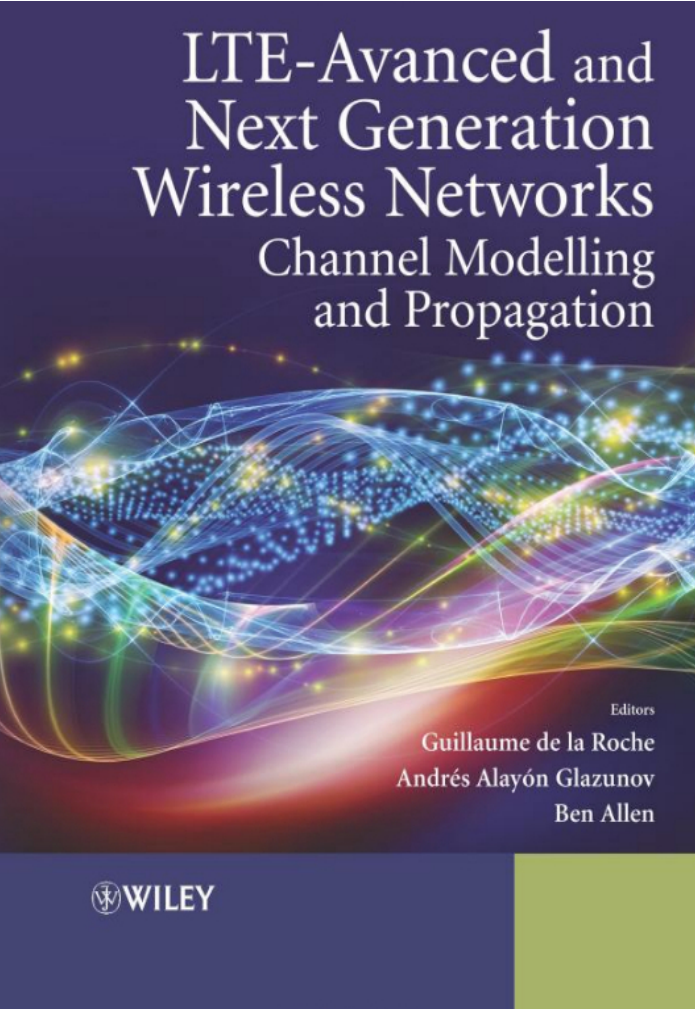

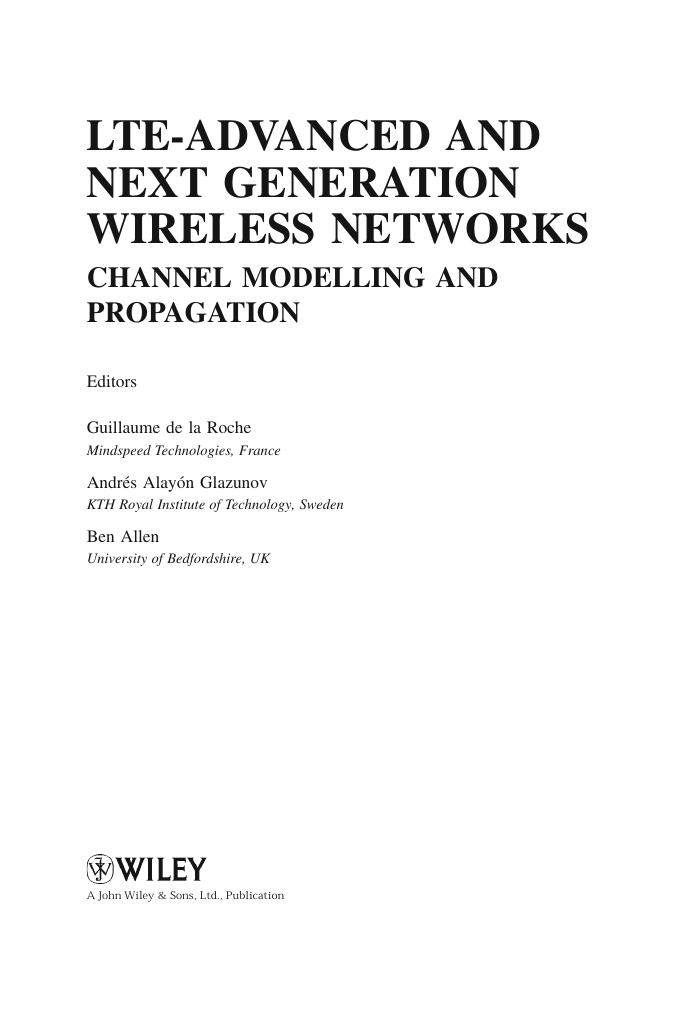
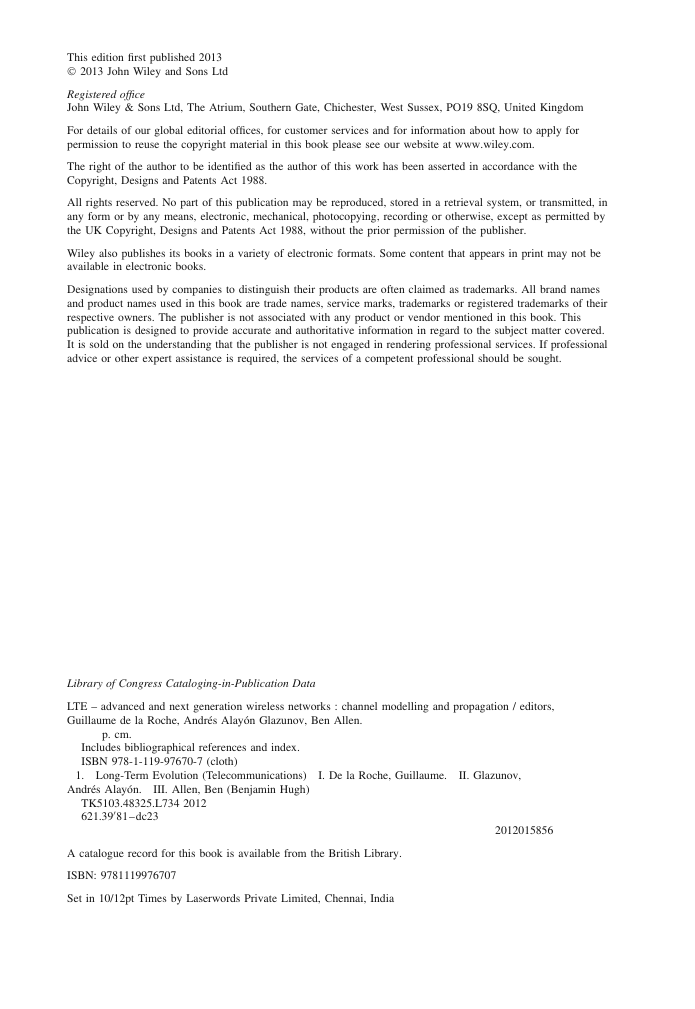
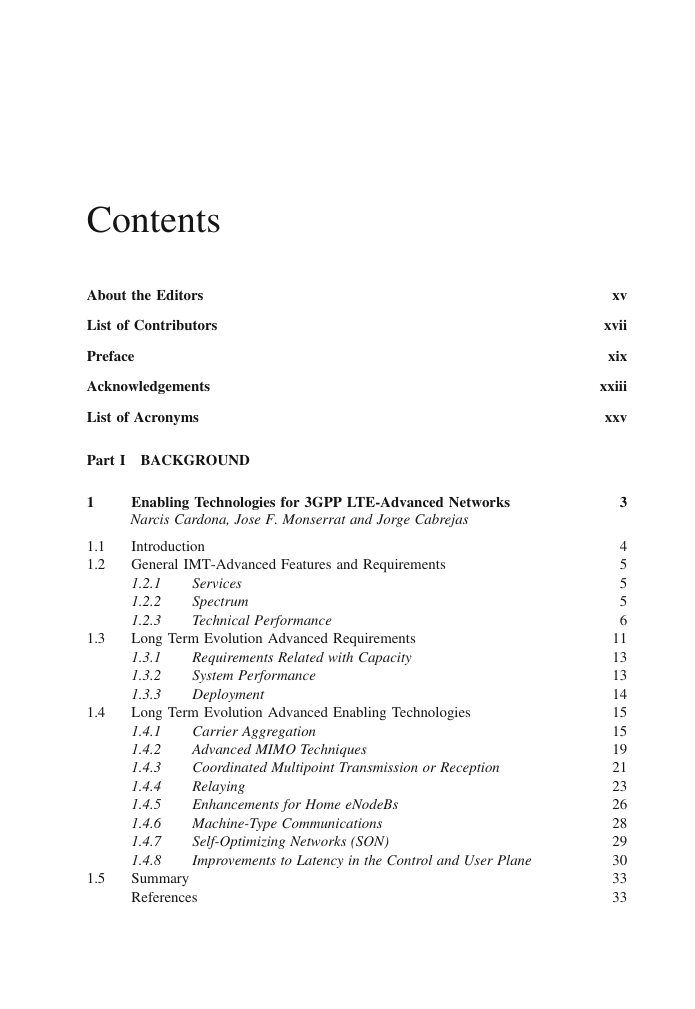
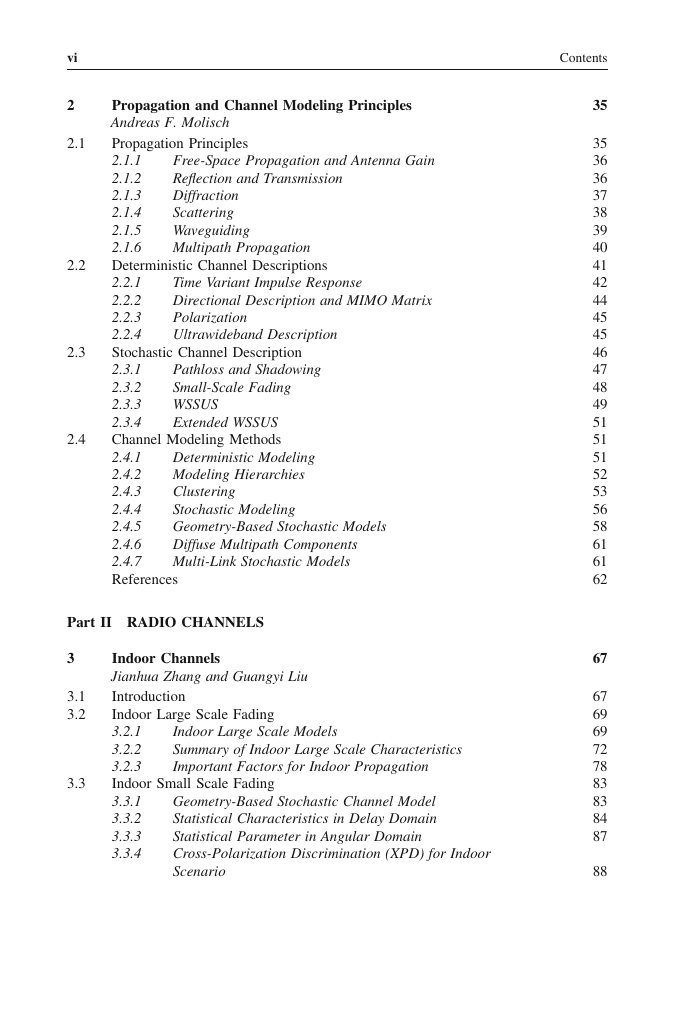
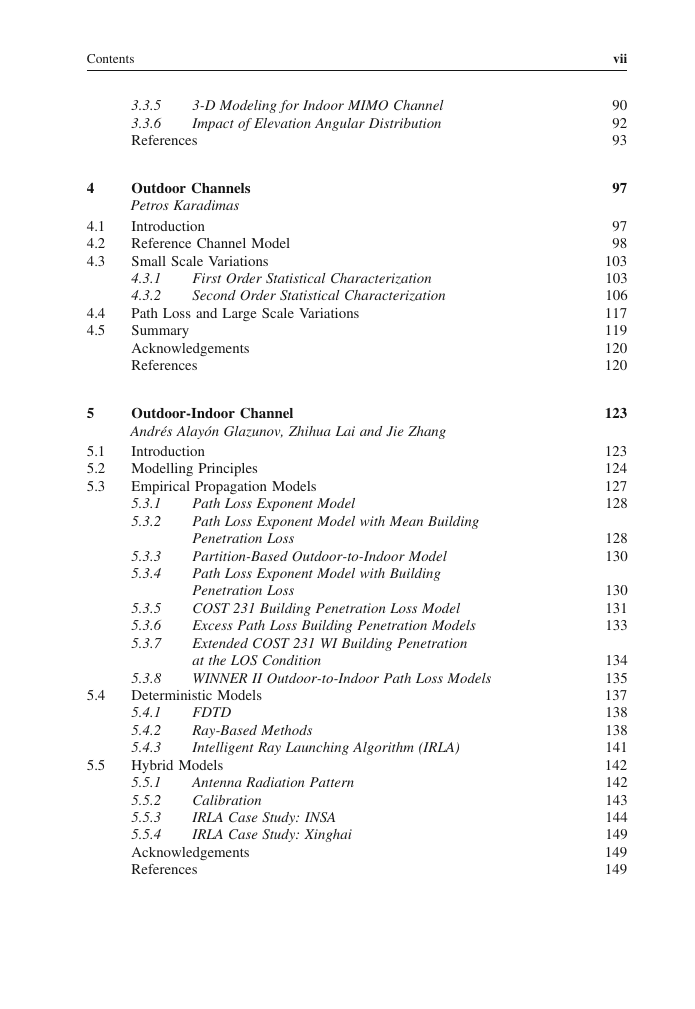
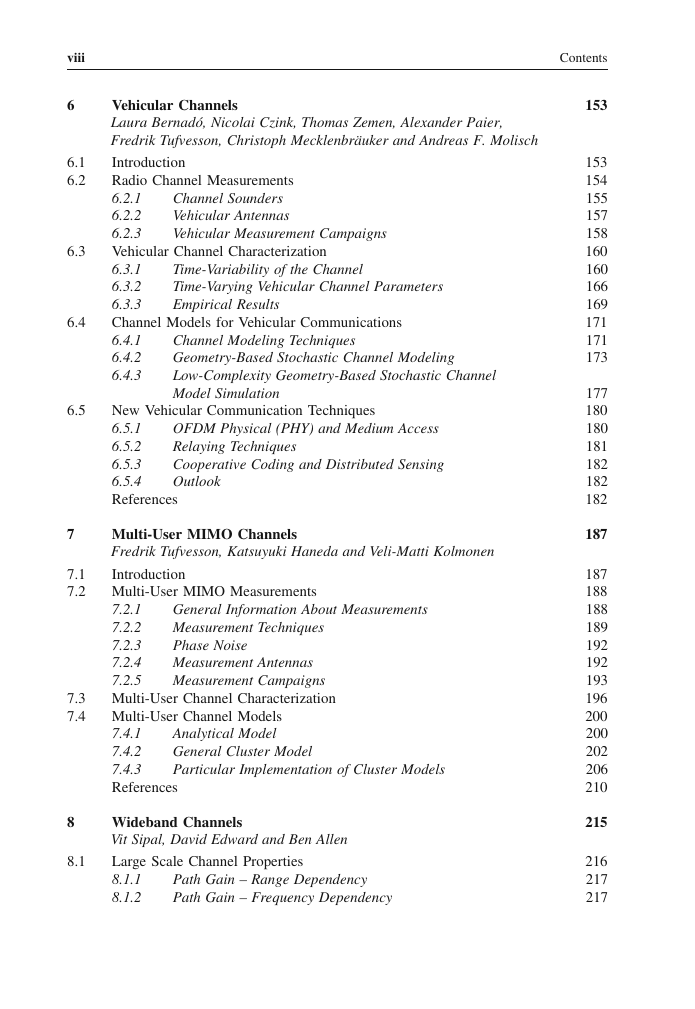








 2023年江西萍乡中考道德与法治真题及答案.doc
2023年江西萍乡中考道德与法治真题及答案.doc 2012年重庆南川中考生物真题及答案.doc
2012年重庆南川中考生物真题及答案.doc 2013年江西师范大学地理学综合及文艺理论基础考研真题.doc
2013年江西师范大学地理学综合及文艺理论基础考研真题.doc 2020年四川甘孜小升初语文真题及答案I卷.doc
2020年四川甘孜小升初语文真题及答案I卷.doc 2020年注册岩土工程师专业基础考试真题及答案.doc
2020年注册岩土工程师专业基础考试真题及答案.doc 2023-2024学年福建省厦门市九年级上学期数学月考试题及答案.doc
2023-2024学年福建省厦门市九年级上学期数学月考试题及答案.doc 2021-2022学年辽宁省沈阳市大东区九年级上学期语文期末试题及答案.doc
2021-2022学年辽宁省沈阳市大东区九年级上学期语文期末试题及答案.doc 2022-2023学年北京东城区初三第一学期物理期末试卷及答案.doc
2022-2023学年北京东城区初三第一学期物理期末试卷及答案.doc 2018上半年江西教师资格初中地理学科知识与教学能力真题及答案.doc
2018上半年江西教师资格初中地理学科知识与教学能力真题及答案.doc 2012年河北国家公务员申论考试真题及答案-省级.doc
2012年河北国家公务员申论考试真题及答案-省级.doc 2020-2021学年江苏省扬州市江都区邵樊片九年级上学期数学第一次质量检测试题及答案.doc
2020-2021学年江苏省扬州市江都区邵樊片九年级上学期数学第一次质量检测试题及答案.doc 2022下半年黑龙江教师资格证中学综合素质真题及答案.doc
2022下半年黑龙江教师资格证中学综合素质真题及答案.doc